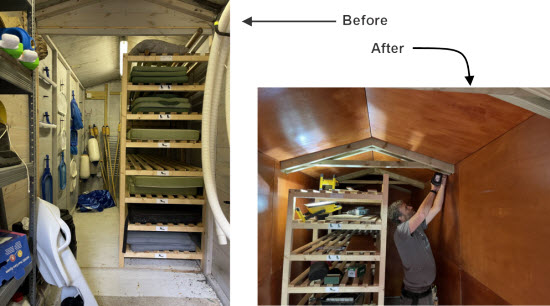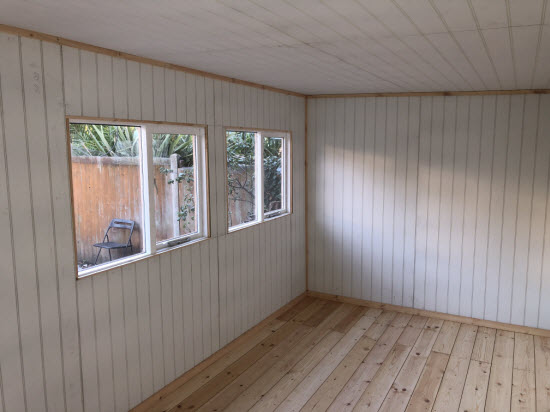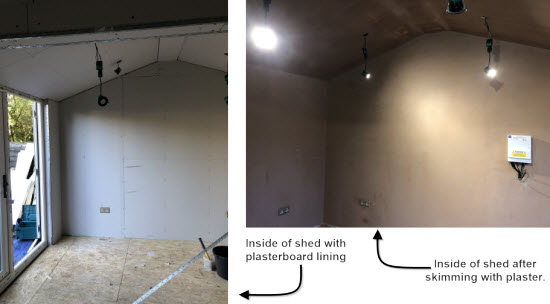Three Shed Linings. Three Very Different Outcomes.
In my line of work, I've seen more than a few sheds evolve from dusty tool stores into impressive workspaces.
There's the workshop I visited with beautifully varnished plywood walls-warm-toned, practical, and easy to wipe down. Another, a shed-turned-office, had opted for plasterboard: clean lines, skimming and paint, but a touch more delicate. And finally, the home gym with a lining of grooved 9mm moisture-resistant MDF, painted a soft grey to mimic tongue-and-groove boards-it looked fantastic, and the grooves gave it a bit of character.
Each shed was transformed. But each material had its trade-offs-some obvious, some less so.
Why Line a Shed at All?
Sheds have come a long way from just housing spades and lawnmowers. A lined shed:
- Improves appearance dramatically, especially if it's going to be used as an office, studio or gym.
- Makes the space easier to clean and maintain-no more cobwebs clinging to rough OSB or bare battens.
- Reduces draughts and dust, even without full insulation.
- Adds structure, allowing you to mount shelves or fixings more easily.
But lining a shed is not just about slapping up some boards. The material you choose sets the tone for the whole space-and may make or break your upgrade.
Three Popular Shed Lining Options (and Where They Shine)
1. Plywood: The Classic All-Rounder
- Pros: Strong, durable, easy to varnish or paint. Holds fixings well. Looks great with a clear finish.
- Cons: Slightly more expensive than MDF. Needs sealing if the shed is prone to damp.
Best for: Workshops, studios, or any space where utility and aesthetics both matter.
 Lining this pool equipment shed with plasterboard made it much easier to keep clean and tidy
Lining this pool equipment shed with plasterboard made it much easier to keep clean and tidy
2. Moisture-Resistant MDF with Grooves: Style and Simplicity
- Pros: Looks like tongue-and-groove cladding. Moisture-resistant options are great for gyms or studios. Smooth finish, easy to paint.
- Cons: Heavy. Not as strong as plywood. Edges must be sealed against moisture ingress.
Best for: Summerhouses, gyms, or design-conscious garden rooms.
 The grooved moisture resistant mdf made an excellent lining for this home gym
The grooved moisture resistant mdf made an excellent lining for this home gym
3. Plasterboard: Clean, But Fragile
- Pros: Gives a domestic finish-flat walls, ready to paint. Can feel more like a proper room.
- Cons: Fragile. Prone to cracking with shed movement or moisture. Doesn't hold weight well unless battened thoroughly.
Best for: Office sheds that are kept dry and don't need much wall fixing.
 The plasterboard lining for this home-office took some time but looked great in the end
The plasterboard lining for this home-office took some time but looked great in the end
What Most People Forget When Lining a Shed
Choosing your board is just one part of the story. Many people assume the job begins and ends with fixing up some panels-but lining a shed properly needs forethought.
Ask yourself:
- What's behind the lining? Will you add insulation? Run cables for sockets or lights? If so, plan it now.
- Do you need a breathable membrane? If your outer walls aren't breathable, lining can trap condensation inside the wall, causing rot over time.
- Will you include a vapour barrier? Especially important if you're heating the shed and want to avoid moisture migrating into the wall cavity.
The Truth About Insulation in Sheds
It seems logical to insulate if you're lining-but here's where size matters.
In small sheds with thin walls, stuffing insulation between battens can cause more harm than good. You rarely get the full 'build-up' needed for it to work properly-meaning no air gap, no moisture barrier, and no escape for condensation.
In many cases, simply leaving a dry cavity and focusing on airtightness is a better bet. Most lined sheds heat up quickly with even a small electric heater, and lining alone can cut down on draughts enough to make the space usable year-round.
Loop Back: What Those Three Projects Taught Me
The varnished plywood looked the smartest long-term. The plasterboard office was elegant but needed more maintenance. The grooved MDF gym had style and was hard-wearing-but needed careful sealing.
Each shed served its purpose, but they were only successful because we looked beyond the boards-we considered moisture, cables, airflow, and usage from day one.
If you're lining your shed, material choice matters. But what's behind that lining may matter even more.

Keep in touch with our monthly newsletter
Shed Building Monthly




